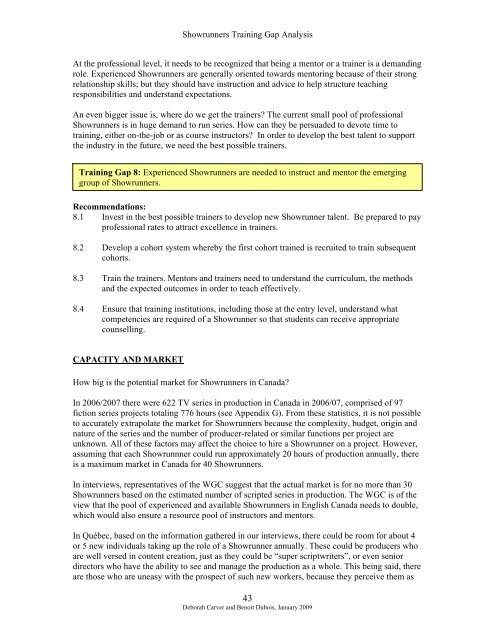Showrunners - Training Gaps Analysis - Cultural Human Resources ...
Showrunners - Training Gaps Analysis - Cultural Human Resources ...
Showrunners - Training Gaps Analysis - Cultural Human Resources ...
You also want an ePaper? Increase the reach of your titles
YUMPU automatically turns print PDFs into web optimized ePapers that Google loves.
<strong>Showrunners</strong> <strong>Training</strong> Gap <strong>Analysis</strong><br />
At the professional level, it needs to be recognized that being a mentor or a trainer is a demanding<br />
role. Experienced <strong>Showrunners</strong> are generally oriented towards mentoring because of their strong<br />
relationship skills; but they should have instruction and advice to help structure teaching<br />
responsibilities and understand expectations.<br />
An even bigger issue is, where do we get the trainers? The current small pool of professional<br />
<strong>Showrunners</strong> is in huge demand to run series. How can they be persuaded to devote time to<br />
training, either on-the-job or as course instructors? In order to develop the best talent to support<br />
the industry in the future, we need the best possible trainers.<br />
<strong>Training</strong> Gap 8: Experienced <strong>Showrunners</strong> are needed to instruct and mentor the emerging<br />
group of <strong>Showrunners</strong>.<br />
Recommendations:<br />
8.1 Invest in the best possible trainers to develop new Showrunner talent. Be prepared to pay<br />
professional rates to attract excellence in trainers.<br />
8.2 Develop a cohort system whereby the first cohort trained is recruited to train subsequent<br />
cohorts.<br />
8.3 Train the trainers. Mentors and trainers need to understand the curriculum, the methods<br />
and the expected outcomes in order to teach effectively.<br />
8.4 Ensure that training institutions, including those at the entry level, understand what<br />
competencies are required of a Showrunner so that students can receive appropriate<br />
counselling.<br />
CAPACITY AND MARKET<br />
How big is the potential market for <strong>Showrunners</strong> in Canada?<br />
In 2006/2007 there were 622 TV series in production in Canada in 2006/07, comprised of 97<br />
fiction series projects totaling 776 hours (see Appendix G). From these statistics, it is not possible<br />
to accurately extrapolate the market for <strong>Showrunners</strong> because the complexity, budget, origin and<br />
nature of the series and the number of producer-related or similar functions per project are<br />
unknown. All of these factors may affect the choice to hire a Showrunner on a project. However,<br />
assuming that each Showrunnner could run approximately 20 hours of production annually, there<br />
is a maximum market in Canada for 40 <strong>Showrunners</strong>.<br />
In interviews, representatives of the WGC suggest that the actual market is for no more than 30<br />
<strong>Showrunners</strong> based on the estimated number of scripted series in production. The WGC is of the<br />
view that the pool of experienced and available <strong>Showrunners</strong> in English Canada needs to double,<br />
which would also ensure a resource pool of instructors and mentors.<br />
In Québec, based on the information gathered in our interviews, there could be room for about 4<br />
or 5 new individuals taking up the role of a Showrunner annually. These could be producers who<br />
are well versed in content creation, just as they could be “super scriptwriters”, or even senior<br />
directors who have the ability to see and manage the production as a whole. This being said, there<br />
are those who are uneasy with the prospect of such new workers, because they perceive them as<br />
43<br />
Deborah Carver and Benoit Dubois, January 2009










